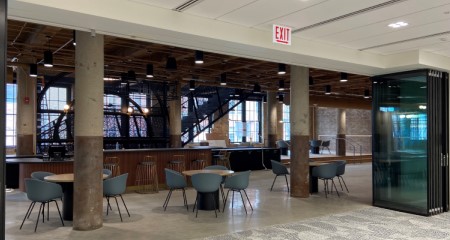Specifying An Operable Wall: What You Need to Know
In previous blogs we’ve explored the benefits of creating flexible space and reviewed the various models and configurations of operable partitions available to help you incorporate flexible space into your design. But how do you get from the initial decision to use an operable partition to a well-crafted specification and viable layout that has been properly detailed?
If you do not work with operable partitions on a regular basis, you may not be accustomed to dealing with the subtle nuances and pitfalls that have the potential to hinder your design. That’s where Modernfold Chicago can help.
Every space transformation is unique, so our approach at MFC is to first understand the space and its intended use. From there we ground ourselves in what is important to the client and what their priorities are. For example, are they more interested in aesthetics, performance, functionality, or ease of use? Often this discussion revolves around understanding potential conflicts and tradeoffs and working to find the right balance. It can also be valuable to determine any budget constraints at this point.
Once the general assessment is complete, we dive into the details and options. Typically, one of the first criteria we attempt to pin down is the partition’s acoustical performance. While an operable partition can impact acoustics in many ways, sound transmission is typically the primary concern. Sound transmission class or STC is a measurement of the partition’s ability to stop sound from traveling from one side of the wall to the other. A wide range of STC ratings are available and the selection can help determine the panel construction, specifically the panel skin substrate. The desired STC and skin substrate can limit the finish options so some compromise may be required.
Along with the acoustic discussion we evaluate the floor plan to determine the length and width of the opening and what configuration would best fit the design. There are many factors to consider at this stage; will the panels stack in-line with the partition centerline, offset from the centerline, or remotely away from the centerline? Are the panels going to be manually set up or will automation be used? Once these questions are answered, we can move on to the finer details of the partitions which include track type, top and bottom seals, and accessories.
Available accessories include work surfaces, pass doors, and pocket doors. The addition of accessories can impact other performance criteria, so again, some give and take may be involved.
Now we are ready to work up the initial partition layout. A complete layout will include panel sizes, elevations, storage and operating clearances, and other pertinent information. A complete specification should accompany the layout and details.
Even with a layout design and specification established the work is not entirely done. Other ancillary items to consider include:
- Support structure
- Floor levelness
- Logistics (elevators)
It is always a good idea to reference ASTM-E557 – the standard guide for architectural design and installation practices for sound isolation between spaces separated by operable partitions. Properly specifying, laying out, and detailing an operable partition requires listening and understanding product options and how they interact with one another.
The Modernfold Chicago team is happy to consult during design to ensure all angles are covered and make the process as seamless as possible. Feel free to reach out anytime.



